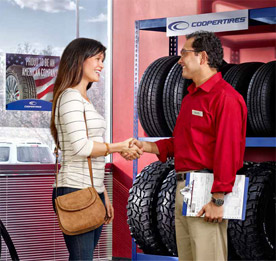Tire Solution: The Influence of Weather Problems
When it comes to making sure optimal efficiency and safety on the roadway, comprehending the impact of climate conditions on tire solution is vital. In this discussion, we will certainly check out the intricate connection in between weather condition conditions and tire solution, shedding light on the value of weather-specific tire upkeep methods and factors to consider.
Warm and Tire Efficiency
When subjected to heats, tires experience adjustments in performance that can dramatically affect lorry safety and security and handling. The warmth generated from extended driving or warm weather problems triggers the tire rubber to soften, causing decreased walk life and enhanced wear. As the rubber comes to be softer, the tire's grip when traveling decreases, influencing braking ranges and general grip. In severe situations, too much warmth can even cause tire blowouts, positioning a serious security threat to the lorry and its owners.
Additionally, high temperatures can speed up the process of tire aging, creating the rubber to deteriorate a lot more swiftly. To mitigate the impacts of warm on tire efficiency, drivers need to on a regular basis inspect their tire pressure, revolve tires to make sure also put on, and check for any indicators of damage.
Winter Impacts
Winter conditions can have a significant influence on tire performance and security. As temperatures decline, tire rubber can set, bring about reduced traction on icy or snow-covered roadways. In winter, tires may additionally shed atmospheric pressure more quickly, which can affect handling and fuel performance. Furthermore, cool temperatures can create tire sidewalls to stiffen, enhancing the threat of damage from holes or various other road risks.
To alleviate the results of winter on tires, it is crucial to regularly check tire pressure and inflate them to the producer's advised degrees. Utilizing winter or all-season tires created for chilly climate problems can likewise improve traction and grip on icy or snowy roads - discount tires morris il. Proper tire maintenance, including routine inspections for wear and damage, becomes much more vital throughout cooler months to ensure optimum efficiency and safety and security
Rainy Issues Impact
Tires with damaged footsteps are extra prone to hydroplaning, where a layer of water constructs up between the tire and the roadway surface area, leading to loss of traction. To fight this, chauffeurs must consistently inspect their tires for sufficient walk deepness and take into consideration investing in tires particularly made for damp problems.

Snow and Tire Safety And Security
Snow-covered roadways posture one-of-a-kind obstacles for motorists, stressing the importance of proper tire selection and upkeep. When driving in snowy problems, having the best tires can make a considerable difference in security and efficiency. Winter tires are created with special rubber compounds and tread patterns to offer better grip on snow and ice compared to all-season tires. The anchor much deeper footsteps and sipes of wintertime tires assist grip the roadway better, reducing the danger of moving and slipping.
Along with making use of winter season tires, it is crucial to guarantee they are effectively blown up. Cold climate can trigger tire pressure to go down, impacting traction and handling (mopar tire service specials). Consistently inspecting and preserving the right tire stress is essential for optimum performance in snowy problems

Weather-Related Tire Maintenance
When confronted with various weather, correct tire maintenance ends up being a critical element of car security and performance. Weather-related tire maintenance encompasses a range of techniques focused on making certain optimum tire function and longevity in you can find out more various weather condition situations. One essential aspect of weather-related tire maintenance is tire pressure law. Changing temperatures can create tire pressure to vary, influencing traction and gas performance. Consistently checking and readjusting tire stress according to producer referrals is essential for secure driving in altering weather. Additionally, tire walk depth plays a substantial role in dealing with various weather aspects. Tires with adequate step depth provide better hold on damp or icy roads, lowering the danger of hydroplaning or skidding. Evaluating tire tread routinely and changing tires when tread wear reaches a particular deepness is essential for maintaining grip and security in unfavorable weather. By prioritizing weather-related tire right here upkeep, chauffeurs can improve safety and security, improve car performance, and extend the life-span of their tires.
Conclusion
In final thought, weather condition problems have a considerable effect on tire performance and safety and security (tire shop morris). From warmth impacting tire stress and put on to chilly weather condition reducing grip, it is necessary to think about the weather when preserving and utilizing tires.
In this conversation, we will explore the complex partnership in between climate problems and tire service, losing light on the value of weather-specific tire upkeep techniques and considerations.
